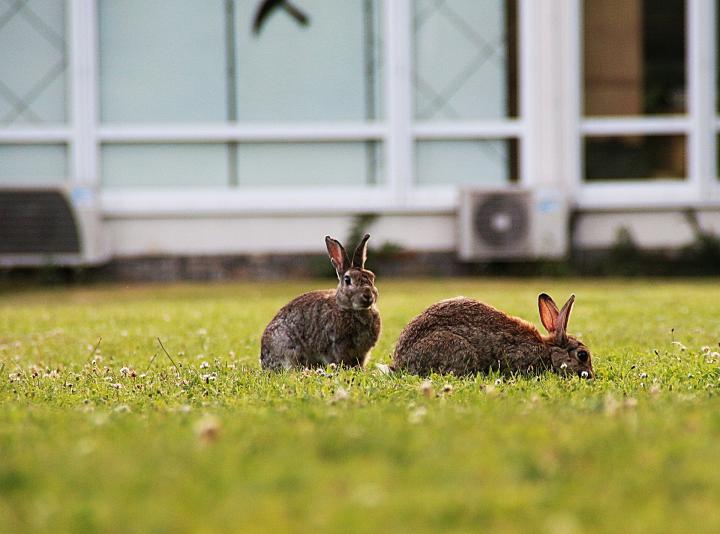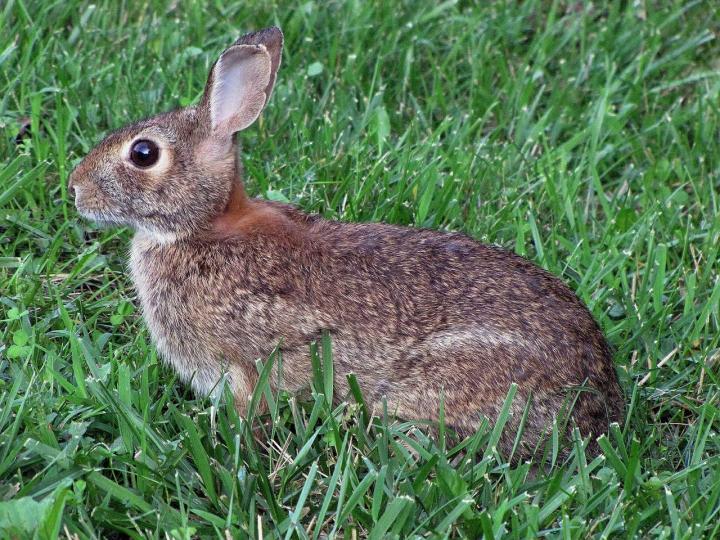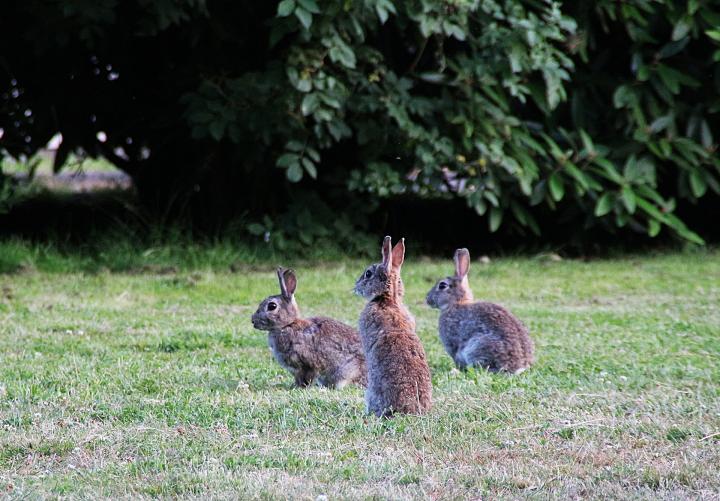how to get rid of rabbits in your yard
Rabbits
How to Identify and Get Rid of Rabbits
How to Identify and Get Rid of Rabbits

Share:
Learn how to get rid of rabbits and keep them out of your garden with these tips.
Why Would You Keep Rabbits Away?
Anyone who tills the soil regards the rabbit as more than a cute threat to the carrot patch. This long-eared animal possesses a voracious appetite for all kinds of fresh vegetation—woody plants, perennials, annuals, vegetables, and berries. In fact, a menu of rabbit favorites is so ridiculously long that it's easier to list the few plants they don't enjoy.
Rabbits also have an extremely high reproductive potential, which is why keeping them around might quickly cause a total garden infestation. They reach up to three litters of six babies each per year in the north, and up to six litters of three babies each per year in the south. The first litter appears in March in the north, year-round elsewhere. The gestation period is 29 days.
Your backyard bunny's primary concern is to eat without being eaten, a difficult task given that rabbits are relished by more than two dozen species of predators. Nibbling your petunias is therefore not a carefree picnic but a danger-fraught mission. However, if your neighborhood bunny can squeeze through a hole in your garden fence, it will be able to munch in safety.
You can check our tips for keeping your plants safe from rabbits, but try to regard rabbits as Beatrix Potter did—part of a peaceful, pastoral landscape. Then protect the plants that you and the bunnies really love, and don't worry about the rest.

Identification
How to Identify Rabbits in your Garden
Of the nine species of North American cottontail rabbits, it's the eastern cottontail (Sylvilagus floridanus) that is our most abundant and annoying. Ranging from Boston to Boulder and south into Mexico, this bunny-about-town is rarely found in forests; preferring instead brushy fence rows, field edges, brush piles, and—you guessed it—landscaped backyards. Its fondness for flowers, vegetables, bark, and bulbs often results in pruned peppers and clipped cosmos.
Even though its nicknames are adorable (among them bunny, bunny rabbit, and cottontail), and you'll probably want to befriend it once you see its cute ears, the eastern cottontail can be a bothersome pest. It is gray or brownish, with a short tail and big ears. It can weigh 2 to 4 pounds, be 15 to 19 inches in length, and live for 12 to 15 months. Its vocal call is almost silent, but it will emit a scream when threatened. Its famous features include a short white tail resembling a cotton ball and long, tapered ears.
For an eastern cottontail, security is a pile of brush, leaves, or another animal's abandoned burrow. Unlike their European cousins, these rabbits do not dig intricate burrows or warrens but make due with what they find. Rabbits rarely leave their shelters in broad daylight, preferring instead early morning or evening. Like most animals, they are sensitive to the change in day length as spring approaches. For rabbits, the longer days signal the start of two things: breeding season and spring dining.
Rabbit Damage
Rabbits are voracious eaters and leave clean-cut damage. Check the leaves and stems of your plants for cleanly cut damage; insects and other pests usually leave jagged edges on damaged plants. This clean-cut damage often happens at ground level, as rabbits tend to eat the yummy green shoots of tulips and other plants.
These low mowers graze close to the ground and sniff out the first tender young shoots and crop them short. They love to munch on flowers, clover, peas, lettuce, beans, and more. Many of these plants are also the favorites of woodchucks or groundhogs, so check for burrows before deciding you have rabbit damage. Once your plants have passed the seedling stage, they are usually safe from rabbit damage.
Although bunny nibbling occurs in every season, it's especially discouraging in the early spring when rabbits mercilessly munch the tender green shoots of plants. As a Connecticut gardener remembers, "My tulips were just poking through the snow when suddenly it looked like they'd been weed-whacked. Cut clean off! I blame the bunnies—their little paw prints were everywhere."

Control and Prevention
How to Get Rid of Rabbits
Though we've mostly been discussing eastern cottontails, keep in mind—these tips should work for any type of rabbit that loves to munch on your plants!
- As their twitching noses indicate, rabbits sniff a lot. Try sprinkling dried sulfur around or on your plants. Rabbits also dislike the smell of onions, so try planting these around your garden to further deter the furry creatures.
- To discourage pesky rabbits, try dusting your plants with plain talcum powder.
- Since rabbits are great sniffers, powdered red pepper sprinkled around the garden or on targeted plants may keep them out.
- Irish Spring soap shavings placed in little drawstring bags around the garden will also help to keep rabbits away.
- Make a bad-tasting rabbit cocktail by grinding together three hot peppers, three large onions, and one whole bunch of garlic. Add water to cover, and place into a covered container overnight. Strain, and then add enough additional water to make a gallon of the mixture. Spray onto plants, repeating after rainfall. Commercial products using pungent garlic oil are also worth a try.
- Spray your plants with a mixture of 1 teaspoon Lysol and 1 gallon of water.
- Some people protect plants with individual "collars" of tin cans or screening so that the plants may reach a less vulnerable size. Put the collar around each stem for protection.
- Use cylinders of ¼-inch mesh hardware cloth to keep rabbits from nibbling on young fruit and landscape trees. The cylinders should extend higher than a rabbit's reach while the rabbit is standing on the expected depth of snow, and they should stand one to two inches out from the tree trunk.
- Some of the deer techniques related to odor are also said to work against rabbits. Deter rabbits with commercially-available deer repellents that contain a mixture of dried bovine blood, sulfured eggs, and garlic.
- Legend has it that rabbits are terrified of their own reflection, so try an old-time rabbit remedy and place large, clear glass jars of water throughout the garden. Garden centers sell ready-made reflectors, as well as other devices—crouching cats, fake snakes, menacing owls—designed to frighten bunnies away from your plants.
- Sometimes, humane traps are the best solution. If you don't want to buy a trap, consider building one. Place the trap where you've seen the rabbits feeding or resting, and cover it with a piece of canvas. Apples, carrots, cabbage, and other fresh green veggies make excellent bait. Check it often, and release bunnies in rural areas several miles away.

How to Prevent Rabbits
The best way to keep rabbits out of the garden is to start early in the spring using the things they don't like, then be consistent throughout the growing season.
- It's best to keep rabbits from crossing into the garden to begin with, and many old-time remedies rely on spreading various products around the perimeter of the garden such as dried blood or dried blood meal or human hair. Sprinkle dried blood on the surface around all your plants as early in the season as you can, and repeat after a heavy rain.Note: If you have dogs, don't try this method because they might be attracted to the scent and start digging up your garden.
- Do not rely on repellents alone. The most effective way of keeping out rabbits is chicken wire fencing. Install a fence that is 4 feet high and bury it 6 inches deep. Bend the top foot of the fence away from the garden like a security fence, so that they can't climb or jump over it. For new bulbs, try a dome or cage of chicken wire secured over the bed.
- Rabbits don't like to leave their shelters, so try to reduce the possible rabbit homes around your yard. Brush away piles of brush and leaves, and fill in abandoned burrows. If a rabbit doesn't have a place to live, hopefully it won't stay and munch. Rabbits will also breed much more if they have a good habitat available—all the more reason to have no vacancy!
Plants That Rabbits Dislike
According to bunny experts, rabbits have plant preferences based on taste, nutritive value, the presence of poison or prickles, and ease of availability. Their tastes in food can also vary by region and season, so not all plants work for all rabbits. Be tricky and tend plants that rabbits don't find very appetizing.
Rabbits tend to avoid some of the same plants as deer and Japanese beetles. If you'd like to control all these pests, check our list of deer-resistant plants and best and worst plants for Japanese beetles to know which plants might do best. Choose plants such as forsythia, lilac bush, marigolds, zinnias, daffodils, lavender, and snapdragons for rabbits. This might help to reduce your rabbit population. This is not a guaranteed solution, as hungry rabbits will eat almost anything, but filling your garden with these plants might make your garden less appetizing than another one. Here are more plants that rabbits dislike:
WOODY PLANTS
Azalea (Rhododendron sp.)
Boxwood (Buxus sp.)
Bush cinquefoil (Potentilla fruticosa)
Butterfly bush (Buddleia davidii)
Cotoneaster (Cotoneaster sp.)
Japanese maple (Acer palmatum)
Mountain laurel (Kalmia latifolia)
Rhododendron (Rhododendron sp.)
Tatarian dogwood (Cornus alba)
Tulip tree (Liriodendron tulipifera)
PERENNIALS
Adam's needle (Yucca filamentosa)
Creeping phlox (Phlox stolonifera)
Foam flower (Tiarella cordifolia)
Lamb's ear (Stachys byzantina)
Meadow rue (Thalictrum rochebrunianum)
Peony (Paeonia hybrids)
Perennial salvia 'East Friesland' (Salvia xsuperba)
Primrose (Primula xpolyantha)
Russian sage (Perovskia atriplicifolia)
Sedum 'Autumn Joy' (Sedum)
Speedwell (Veronica sp.)
Spring cinquefoil (Potentilla verna)
Stokes' aster (Stokesia laevis)
ANNUALS
Four o'clock flower (Mirabilis jalapa)
Geranium, zonal and bedding (Pelargonium xhortorum)
Mexican ageratum (Ageratum houstonianum)
Pot marigold (Calendula officinalis)
Spiderflower (Cleome hasslerana)
Vinca (Catharanthus roseus)
Wax begonia (Begonia xsemperflorens-cultorum)
BULBS
Daffodil (Narcissus sp.)
Hyacinth (Hyacinth orientalis)
Persian onion (Allium giganteum)
VEGETABLES
Asparagus
Leeks
Onions
Potatoes
Rhubarb
Summer squash
Tomatoes
HERBS
Basil
Marjoram
Mint
Oregano
Parsley
Savory
Tarragon
Do you have any tips for controlling rabbits in your garden or yard? Please post below!
Topics
What do you want to read next?
how to get rid of rabbits in your yard
Source: https://www.almanac.com/pest/rabbits#:~:text=To%20discourage%20pesky%20rabbits%2C%20try,help%20to%20keep%20rabbits%20away.
Posted by: plattbefoom.blogspot.com

0 Response to "how to get rid of rabbits in your yard"
Post a Comment